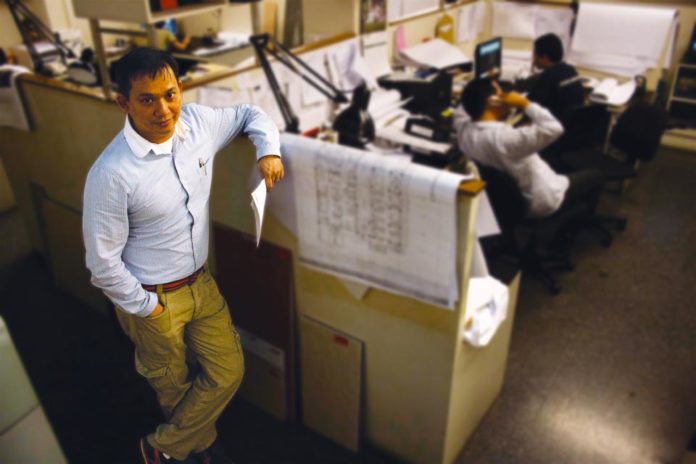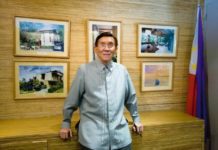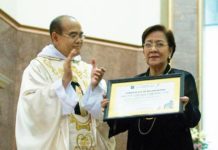WHAT was a brief childish fascination with a compass, a ruler, and a lettering set in his father’s office turned out to be a cornerstone in the life of Daniel Lichauco, a principal architect of the architectural firm, Archion Associates.
“I could not draw free hand,” confessed Lichauco in an interview with the Varsitarian. “I realized that using drafting materials would help me draw something really nice.” Buoyed by his new-found interest, Lichauco dedicated his high school endeavors to pursuing a life in technical drawing. He was determined to become an architect that he left the comforts of Ateneo, where he took his elementary and high school education, to pursue architecture in UST.
“It was supposed to be Ateneo all the way, but since it had no architecture program I chose UST, which has one of the best programs in the country,” said the part-time College of Architecture professor.
The quest of the young aspiring architect’s from New Manila also meant embarking on a career path none of his relatives have taken since his family line was in business and teaching. It was also a leap of faith for a child who once dreamt of becoming a priest.
Drawing inspiration
Lichauco’s first year in college was a struggle, best described by his lack of confidence in his works and the threes marking his transcript.
While Lichauco’s academic standing frustrated him, the change of scenery from an exclusive all boys’ school to a co-ed university amused him.
“I was really happy when I entered UST because architecture is about experiencing a lot of things. If I had stayed in Ateneo then my experience would have been really limited. But in UST, because of the broad cross-economic and social make-up (of the students), it became a lot easier and interesting (for me),” Lichauco said.
Things, however, started to change for the better in his third year, when Cory Cruz, one of his professors, took notice of his talent for drawing.
“She was the first one who told me I was good at what I do and then giving me high grades,” Lichauco said.
His professor’s words of encouragement motivated Lichauco from then on to excel in his studies, particularly in geometry and design.
“That’s when I started getting high grades in design. And I said to myself I could do this, and not be the kulelat in class,” he said.
Lichauco graduated in 1986 with grades good enough to land him a scholarship as a teacher in the United States. After passing the Philippine Architecture board exam in his second take—the first time he failed in history of architecture—he left for University of Michigan, where he earned his master’s degree in architectural design and theory, and in urban planning in 1991. He later on took a master’s degree under another scholarship in classical architecture and urban design at University of Notre Dame.
However, the long years in graduate school finally took its toll on Lichauco.
“By my third degree, I was already tired of studying, so I decided it was time to start working,” said Lichauco, who returned to the Philippines after earning his last master’s degree from the University of Norte Dame in 1993.
Ninoy connection
In 1994, Lichauco worked for Francisco “Bobby” Mañosa’s firm as a partner, where he earned P15,000 a month and learned from the “master” architect himself. Before long he finally decided to establish his own firm.
“A part of my family’s nationalism is (for me) to come back because the Philippines was really good to us despite martial law being declared in the country,” the nephew of the late Sen. Benigno “Ninoy” Aquino said.
The late Sen. Aquino was an opposition leader during the Marcos dictatorship. He was imprisoned then martyred upon returning to the Philippines from exile in the U.S. on August 21, 1983 at Manila International Airport, which was renamed after him.
As a testament to his uncle’s legacy to the country, Lichauco designed the Aquino Center in Luisita, Tarlac for his thesis, which he later improved and built when he was still working for Manosa’s firm under his family’s commission.
Contribution to environment
While working at Mañosa and partners, Lichauco learned another development in his discipline.
“One of the lessons that I learned from Bobby Mañosa is environmental architecture. He designed Pinoy buildings for the environment,” Lichauco said.
He explained that environmental architecture could be divided into two, by design and by toys. The former focuses on adapting the structure of the building to its needs like harnessing wind patterns for it ventilation or protecting it from heat. Meanwhile, the latter utilizes like solar panels and heat and exchange pumps to reduce its maintenance requirements.
Mañosa’s firm was already designing environmental structures before it became a trend with the looming threat of global warming.
Even after he established, Archion Associates, Lichauco retained the values and style of his former employer. Specializing in complex building designs like hospitals and laboratories, Archion Associates designed environment-friendly structures like the Ateneo School of Medicine and Public Health, the Jose Rizal University Gymnasium, and the master plan for the Far Eastern University in Silang, Cavite.
Giving back
Despite the heavy workload in his fledging firm, Lichauco still finds time Lichauco to teach history of architecture and architectural theory design in UST. He realized after traveling to Europe and the United States to share valuable knowledge he learned in his trips to these places. In 1995, he applied for a teaching position at the College of Architecture.
Lichauco also occasionally writes for newspapers and magazines like Blue Print, Metro, and the Philippine Daily Inquirer regarding architectural designs and green architecture.
Now sitting comfortably in his own office at Archion Associates, Lichauco has come far from his humble doodles in his father’s office that faithful summer. Despite his achievements, Lichauco doesn’t forget the roots of his success.
“The foundation UST inculcated in me in terms of the hard work in getting the things done and making thing do with the available resources led me to realize that UST prepared us really well,” Lichauco said.











